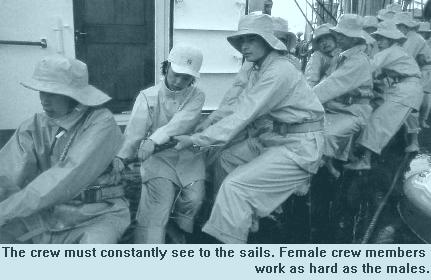

![]()
Facing the starting line, 40 sailboats from 17 countries and one region, including Indonesia, Argentina, Colombia, Oman and Poland, were hoisting their sails. White canvas sprouted from the yards of one boat, then another, and another. . . flapping in the breeze off the water like white flowers suddenly come into blossom. Swelling before a fair wind, they described beautiful large curves as each sailing ship began to move. The noise of engines was no longer to be heard.
The time was 11 a.m. on April 22 and the second race of the Sail Osaka ’97 - International Sailing Ship Race commemorating the centennial of the opening of the port of Osaka was under way off Sata Point, Kagoshima Prefecture. Two sailing ships belonging to the Institute for Sea Training of the Ministry of Transport the Nippon Maru and the Kaio Maru - were competing in the major 600-kilometer race to the Kii Channel off Osaka.
The ship sailed round-the-clock, taking advantage of fair winds whenever, they sprang up. The crew worked hard to make best use of every bit of wind, not taking a moment’s rest. It requires intense effort by every member of the crew to unfurl all sails of a tall ship like the Nippon Maru, which has 36 sheets altogether on its four masts, the main one 45 metres tall. At the sign from the captain and under instructions from the navigation officers, the crew members loosened the sails from their yard lashings one by one. The entire operation, done by hand and by manipulating the ropes, sometimes took more than an hour.
It seems like a smooth departure, but soon after the start, the Nippon Maru’s bow swung - would you believe it - southward. Osaka, of course, was to the east. . . One soon learns that sailing vessels are much at the mercy of the wind.
 Work
on the ship never stopped. The crew was divided into six groups and the 24-hour
day into six four-hour watches - three each in the morning and afternoon, with
two groups assigned to each watch. From time to time, the ship was greeted by
porpoises and whales, which helped to ease the tension of crew members on duty.
Work
on the ship never stopped. The crew was divided into six groups and the 24-hour
day into six four-hour watches - three each in the morning and afternoon, with
two groups assigned to each watch. From time to time, the ship was greeted by
porpoises and whales, which helped to ease the tension of crew members on duty.
The direction of the wind failed to change. And so, on the fourth day, the Nippon Maru was forced to quit the race. This came as a real disappointment for the crew, even though they had entered as only a part of their training. But one crewman had this to say: "When the Nippon Maru calls at a port in Japan, a lot of people come out to see it. I feel proud just to have had a chance to serve as a member of its crew."
A sailing ship never fails to capture the imagination of the public. This may be indicative of people’s admiration for the windjammers that symbolized the Grand Age of Discovery. Some 570,000 spectators gathered at the port of Kagoshima to get a glimpse of the elegant tall ships that came from various parts of the world to take part in the Kagoshima Sailing Ship Festival, held just before the start of the Osaka race. The festival was rich in international flavor with 2,000 or so crew members dancing and singing joyously with the local people as the participating ships were opened to the public.
At the port of Osaka, the goal of the Sail Osaka ’97 competition, the tall ships took part in a sail past, followed by gala parties aboard the ships and athletic events joined by both crewmen and local citizens. At night, a huge fireworks display brought into relief the silhouettes of the ships moored in the port.
One female member of the Nippon Maru crew, with a look of deep satisfaction on her face, gave this account of her experience: "Life on a sailing ship is really hard. The seasickness we experienced was nothing like that we’d known before. Handling the ropes amid strong winds and pouring rain was especially hard. But pulling through all this enabled me to have confidence in myself. I’m really pleased to have had this rare chance to participate in the race and meet with crew members of sailing ships from various other countries," she said.
Return to the Plus contents page
![]()
| HOME PAGE | FRONT PAGE | EDITORIAL/OPINION | NEWS / COMMENT | BUSINESS
Please send your comments and suggestions on this web site to
info@suntimes.is.lk or to
webmaster@infolabs.is.lk